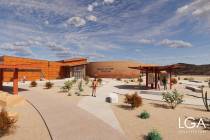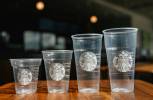Don’t trash yard waste, compost it
With the arrival of fall, we start ripping out our summer gardens, raking leaves and cleaning up other garden debris. Once it's gathered up, don't send it to the landfill. Compost it.
Composting experts Cindy Dixon and Bernie Schwab will show you how to turn your waste products into compost to improve your gardening experiences at 8:30 a.m. Saturday and Nov. 11 at the Springs Preserve, 333 S. Valley View Blvd. Call 822-7700 to register for this class.
Much of what goes into our trash cans can be composted. Recycle your kitchen waste, weeds, grass clippings, leaves, small twigs and other yard debris through your compost pile. Newspapers and hair from pets and people also easily decompose.
Frequent additions of decomposed organic matter will help you retain soil moisture, create aeration and will provide a steady supply of essential nutrients to your plants.
Living in a compost pile is no walk in the park. Even if you happen to be at the top of the compost food chain, bugs can gobble you up. So, lets dive in and learn who rules in the compost heap.
Almost anything that was once living is a candidate for composting. There are exceptions to this rule: grease, oil, meat scraps, human and pet excrement. Do not add these to your compost pile.
Composting requires some basic knowledge about the organisms that perform the task of decomposition and their basic needs. These microorganisms are your workforce. Take good care of them and they'll convert your waste materials into rich humus quickly.
Keep the pile moist so microorganisms can do their composting. Too much moisture prevents oxygen exchange, and too little will slow their ability to do their work.
Plants take in carbon dioxide during photosynthesis and incorporate it into cell walls, proteins, sugars, nucleic acids (DNA and RNA) and lipids (fats and oils). Just as we consume foods and convert them to carbon dioxide through respiration, organisms in the compost pile use the organic residues you add to your pile.
These microorganisms need only small quantities of nitrogen to meet their needs, otherwise they won't decompose. Nitrogen is a major constituent of protein and nucleic acids. Use green plant residues or nitrogen fertilizers to bring nitrogen into balance with the raw materials.
The microorganisms that start the process are in the air and soil. By adding small amounts of topsoil to your compost, you inoculate the pile.
The organisms in the compost use carbon and nitrogen to reproduce and grow more, and that means breaking down the organic matter quicker.
Within the compost pile, there is a food chain with many different organisms feeding on raw materials and each other. Fungi, bacteria, actinomycetes, insects and worms feed on the raw organic matter. Others feed on the fungi. Protozoans, roundworms, and others feed on bacteria. All the organisms produce waste and/or die to create the compost. It's a real jungle in there.
In theory, composting can be finished in two weeks if you use compost tumblers or rotating drums and if you are on top of your game.
Here is a guideline to follow when composting:
1. Select an inconspicuous spot in the yard. Place something like a 3-foot-high wire fence around it to form a 6-foot circle.
2. Place a layer of yard debris, straw, kitchen scraps and grass clippings about a foot thick in the bin.
3. Cover the plant material with 2 to 3 inches of garden soil to introduce microorganisms into the compost.
4. Dust the pile with a nitrogen-type fertilizer to hasten microorganism action.
Repeat steps 2, 3 and 4 often to mix the materials on the outer edges into the center of the pile. Add water if it seems dry.
5. Keep the pile moist and wash the topsoil downward. Don't let it dry out. To hasten decomposition, make a concaved saucer on top of the pile and water weekly.
Here are some reasons why your compost pile might not be working:
■ It is either too dry or too wet.
■ It is lacking sufficient nitrogen. Add some to get it working again.
■ If the pile smells like ammonia, you added too much nitrogen. In any case, add more raw materials to get it cooking again.
Many people have toys they use to make and monitor their compost. These include shredders, thermometers, manufactured bins and handy gadgets to help you turn it.
Linn Mills' garden column appears on Sundays. He can be reached at linnmillslv@gmail.com or call him at
702-526-1495.























